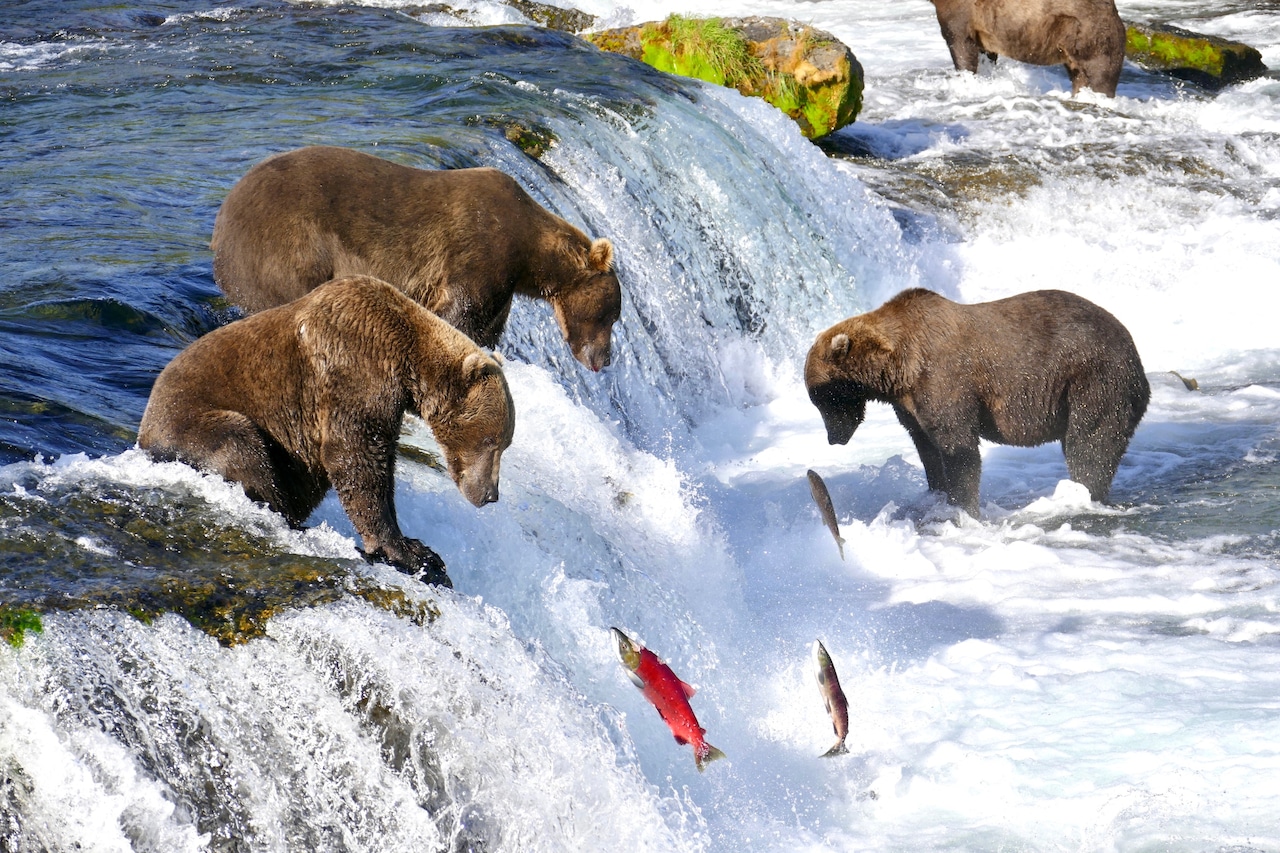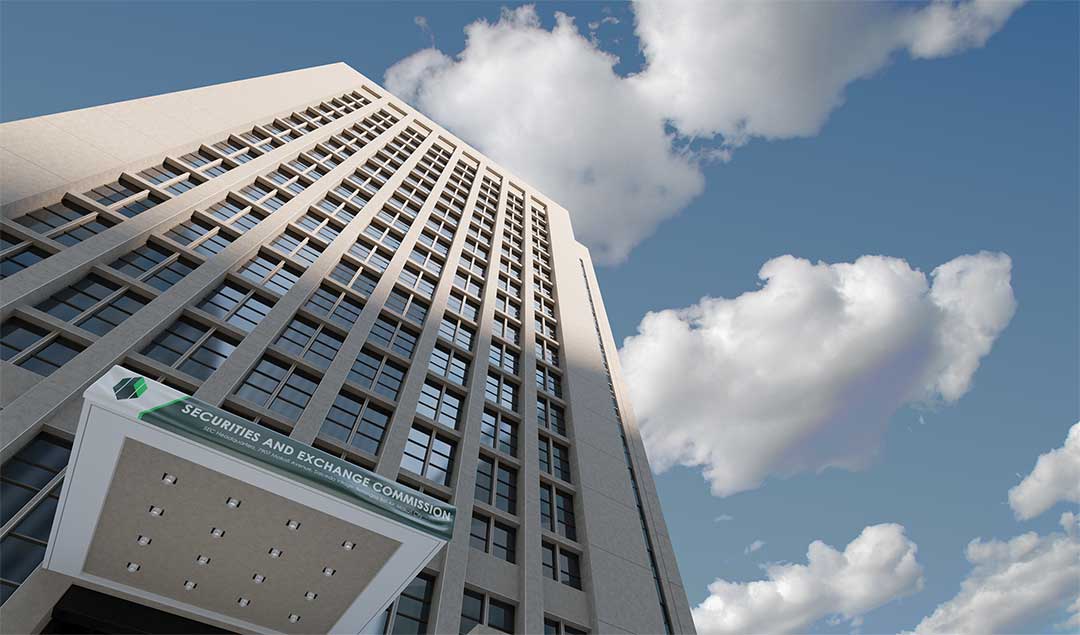
Patty Salkeld of Portland has been voting for years in Explore.org’s spirited Fat Bear Week competition. Starting Tuesday, she will once again join millions of viewers, glued to a live webcam at Alaska’s Katmai National Park & Preserve, and pick her favorite wild brown bear bulking up on salmon before hibernation.
For this year’s 11th annual tournament, which runs Sept. 23-30, Salkeld has an advantage in sizing up the bears to fill out her tournament bracket: She’s seen some of them in real life.
In July, the retired teacher and lifetime wildlife enthusiast flew in three progressively smaller planes 2,000 miles northeast to the remote Katmai National Park.
The 4 million-acre park on the northern Alaska Peninsula borders Bristol Bay, the largest sockeye salmon fishery in the world. This makes Katmai the prize destination for those, like Salkeld, who want to see and photograph bears in the wild.
There, at Brooks River where the web cameras are stationed, Salkeld encountered the hefty, opportunistic omnivores up close, while maintaining a safe distance.
She, like all visitors to Katmai National Park, learned at Brooks Camp “bear school” that this is protected wildlife territory and bears have the right-of-way.
People step off the trail if a 1,200-pound male bear lumbers by. They walk in groups and talk — some repeating, “Hey, bear” — to avoid startling free-roaming mothers and cubs.
If visitors come face to face with a bear, they’re instructed to stay calm and wave their arms to look big.
Park rangers explain that the bears that grow to be exceptionally large here due to their salmon-rich diet are not hungry and are accustomed to an audience watching their innate behaviors.
They just want to move on.
Rangers point out that no humans have been killed by bears at Brooks Falls in the camp’s 75 year history.
Salkeld said she and her three cabin roommates stopped quickly when they saw two juvenile bears on the ground, looking around.
“The rangers tell you not to run, and that was my first instinct, but we didn’t,” Salkeld said. “The subadult bears weren’t looking at us. They wanted nothing to do with us.”
Guests are required to stay at least 50 yards from the bears, unless the people are elevated above the ground on a gated viewing platform. Up there, Salkeld watched two young bears playing in the grass just 10 feet below, offering a rare close-up view while maintaining safety.
The real action, however, takes place in the water at Brooks Falls, considered one of the last great salmon runs on earth. Here, a parade of sockeye salmon leap in front of the bears, making it easy for the bears to catch the fish with their powerful jaws.
“The bears have a hierarchy and their favorite fishing spots at the falls, and they do a lot of posturing and roaring to get another bear to back down,” said Salkeld, who taught for 25 years in the Reynolds School District and sixth graders at the weeklong Outdoor School.
“It’s very spiritual for me to see wildlife that has never been hunted or harassed by humans,” she added. “We are their guests.”
Food, scented items like toothpaste and chewing gum and gear are stored in bear-resistant buildings.
Visitors can eat only in dedicated dining spaces, either in the 1950-built Brooks Lodge‘s dining hall, where meals are served three times a day, or at sheltered picnic tables.
Overnight guests pop up a tent inside the campground’s electrified fence for $10-$18 per person per night. Or, if they win a random drawing lottery, they can stay in the 16-room Brooks Lodge where a cabin with four bunkbeds cost about $1,100 a night.
Salkeld decided to splurge on a cabin and through the lottery was able to stay one night in the peak of feeding season.
Fat Bear Week
This turned out to be a great year for bear watchers at Brooks Falls.
Rangers estimate 62 million sockeye salmon, a vital source of fat and protein for coastal bears, passed through this summer. The abundant and prolonged stream of the blazing red fish benefited the park’s about 2,200 residents bears.
And the feasting has created ideal conditions for an exciting 2025 Fat Bear Week competition. Last year, 11 million viewers worldwide tuned in to watch Brooks Falls’ eight bear cams. And more than 1.2 million votes were cast last year at fatbearweek.org.
Participants compare early and late summer photos of bears that gain hundreds of pounds, and decide which one has exhibited smarts, resilience and determination to survive winter hibernation.
The largest male brown bears can rise 10 feet tall and after a summer of eating, weigh as much as a polar bear.
Burly Otis (bear 480) is the record-holder for most salmon consumed in one sitting. The bear, voted Fat Bear Week champion in the contest’s first year in 2014 and again in 2016 and 2017, was observed by rangers eating 42 salmon (about 240,000 calories) in 5.5 hours.
At around 800 pounds, skillful Grazer (bear 128), with her female cub Biggie just named 2025 Fat Bear Jr., could earn her third Fat Bear Week championship.
The bear with the most votes in each matchup advances to the next round. The one with the most votes will be crowned Fat Bear Week champion Sept. 30.
Salkeld, who keeps Explore.org’s bear webcam streaming from mid June to mid October on her computer, hopes to return to Katmai National Park & Preserve if she can win the lottery again to stay at Brooks Lodge.
“I can’t wait to go back, and I could go back over and over and over,” Salkeld said of the park that cannot be accessed by car. “Observing and photographing bears playing, fishing and eating in their natural habitat was a pinnacle for me.”
Returning to Brooks Falls
A small group of webcam viewers and Fat Bear Week voters can say they’ve actually been to the Katmai wilderness. Fewer still can say they witnessed feeding season, when brown bears are feasting in salmon streams, sedge meadows and mud flats where they devour clams.
Eva Thiemann, a nurse, naturalist and artist who lives in southern Oregon’s Rogue Valley, first visited Katmai National Park in 1998.
She stayed in a tall tipi at Brooks Camp campground, before the electric fencing was installed. She returned, half of the time on solo trips, in 2006, 2009, 2012, 2013, 2017 and 2018.
And in August, on her eighth visit, she introduced her partner Ron Avery to the scene. “This is a unique place, where animals are not hunted, bears are just doing their own thing and minding their own business,” she said.
They camped seven nights, the maximum allowed, and carried in everything they’d needed, from a tent to homemade jerky.
Avery, an experienced camper and retired engineer, didn’t have the bear spray he thought he needed, but he said he felt safe. They had three bear encounters, mostly on paths through the woods.
“Many of us have seen the videos of bears catching fish on top of Brooks Falls,” Avery said. But being there in person, “was one of the top experiences of my life.”
Avery packed nutritious, quick-to-reheat food like sweet potato stew with chickpeas along with sesame seed bars that he prepared, dehydrated, and vacuum-sealed at his Jacksonville home before the trip.
Still, he lost four pounds, he joked, spending time with Thiemann watching the bears from the platforms. They left their tent early in the morning, and didn’t return to the camp until around 1 p.m. to have their first meal.
Thiemann was eager to walk in the early morning, rain or shine, to stand on the Brooks Falls platform, overlooking Brooks River and Naknek Lake where the bears congregate at the salmon run.
Her visits to national parks inspire her art. Her oil paintings of Brook Falls brown bears, southern Oregon great grey owls and wolves she saw in Brooks Falls, Denali National Park and Yellowstone National Park have been exhibited in Oregon galleries.
“I feel there is an unfair attitude toward animals like wolves and bears, which have a hard time surviving in the world dominated by humans,” said Thiemann.
“For me, a brown bear is a symbol of wilderness, a symbol of undisturbed nature,” she said.
Thiemann and Avery hope to return to Brooks Camp if they are lucky enough to get a camping permit.
In the past, Thiemann enjoyed watching cubs being weaned off their mothers on their second or third summers and learning to tend for themselves.
“Sometimes siblings hang out together for a while for safety and companionship, then they part to live a solitary life of an adult bear,” said Thiemann.
Some years, when salmon was scarce, Thiemann saw female brown bears, called sows, with cubs fishing further down from the falls.
Stronger and bolder sows took their cubs on top of the falls and would fight off big male bears, called boars, to get a better fishing spot, she said.
She studies their different demeanors and tempers to recognize individual bears. “A few bears choose not to work so hard, but rather fight to steal other bears’ fish,” she said.
A bear nicknamed Scarface by rangers had body scars from battling bigger bears.
She has seen a bear with a broken front leg fishing on top of the falls, another bear had a broken jaw: “And they kept fishing,” she said.
Thiemann’s videos of the Alaska Peninsula brown bears were included in National Geographic TV shows “King Bear,” “Planet Carnivore,” “Animal Fight Night” and “Urban Jungle.”
Even researchers are still discovering new aspects of these bears’ behaviors and habits, she said.
“No one knows everything about them,” she said. “It’s a privilege just to observe them in their natural habitat.”
If you go: Katmai National Park & Preserve spans more than 4 million acres. Park headquarters is at 1000 Silver St., Building 603 in King Salmon, Alaska.
Visitors typically take an air taxi flight from Anchorage to King Salmon and a small float plane or boat to Brooks Camp, at the mouth of the Brooks River and the shore of Naknek Lake.
Brooks Camp has lodging, a dining hall serving three meals a day and a camp store, and is about a mile to the Brooks Falls viewing platform.
Information about day trips and overnight cabin reservations at 16-room Brooks Lodge is available at katmailand.com or by calling 800-544-0551.
From June 1 to Sept. 17, the National Park Service operates a visitor center, ranger station and an auditorium with daily ranger-led programs.



